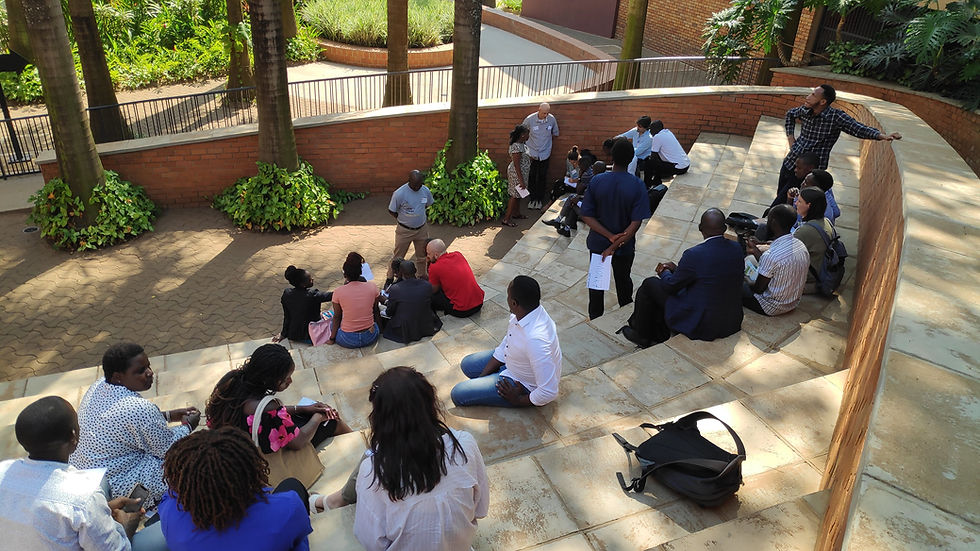Cultural identity and the classroom
- info8381132
- Jul 7, 2023
- 4 min read
Meg Collin, Field Officer
“Schools began with a man under a tree, who did not know he was a teacher, discussing his realization with a few, who did not know they were students.”
Louis Kahn
Last week we ran a two-day design workshop for final year architecture students at the University of Rwanda in Kigali. It marks the start of a year-long collaboration with their School of Architecture and the Built Environment, during which time we will teach and test the principles of the schools design guide, drawing on the experience of Rwandan students to develop our guidelines. We encouraged the students to ask difficult questions and even to disagree with our proposed manifesto for schools design, in order to critically analyse our research. In the midst of discussing how to balance the ideals of an educational environment with the pragmatic nature of resource-constrained schools, one student asked the question: ‘How can we retain our cultural identity in the design of schools which follow an essentially 'Western' or 'colonial' model?’.

A student writes up their manifesto for schools design in Rwanda (G Muzamhindo)
A broad-brush look at the evolution of education in East Africa begins with teaching in indigenous cultures. Here, all community elders served as teachers, education was about listening and doing, and it encompassed practical skills as well as customs, traditions and morals – educationalist and researcher Mosweunyane says ‘knowledge and information acquired was to enable its recipients to understand the reality of the world.’ [R1] Colonisation led to a shift in education and a more compartmentalised approach, where the primary teaching method was of the student listening to the teacher (so-called teacher-centred learning), education took place in a designated school building and subject matter was more focussed on academic areas such as literature, science and religion. Over a century later and this style of education is still the predominant kind in African countries, often resulting in a lack of student understanding, of literacy and of critical thinking.

A typical classroom set up for ‘teacher-centred learning’.
Times are changing, however, and both Uganda and Rwanda have had new curriculums in recent years, promoting 'pupil-centred learning.' Also known as active teaching and learning (ATL), this method invokes both listening and doing, covers a broader curriculum of practical and theoretical understanding, and encourages education to happen outside the classroom. Our challenge is to consider what spaces for this new style of education should look like, and how, as the student asked, they can reflect the local culture - acknowledging that it too has changed since the indigenous era.
1. The school as the heart of the community
In a village culture, the place of learning forms the heart of the community. As society urbanises and the geographical heart of the community is less evident, the need for schools to provide a community base becomes more acute. From involvement in its design and development, to sharing its green and gathering spaces, or from participating in the education of its children to providing a space for adult learning, there are numerous ways that the design of schools can encourage this.

Anwa Junior Academy in Kibera, Kenya was started by a group of mothers living in the informal settlement. Kounkuey Design Initiative worked with the community to design a new school building for the growing school. (KDI)
2. Flexibility of classrooms
Active teaching and learning requires different spaces to students sitting in rows of desks. Classrooms should be designed to enable flexibility in layout and for different teaching and learning styles to take place. They should include space for storage and interactive displays, as well as being adaptable to current and future use of technology.

Mustardseed Primary has classrooms which can adopt multiple different arrangements of furniture and which have spaces for groupwork and storytelling.
3. Vocational Training Facilities
Whether entrepreneurship or radio, tailoring or carpentry (the list goes on), vocational training makes up core elements of the new curriculum and the school environment should reflect that. Practical skills training brings opportunities to involve the wider community and can bring in revenue to support other school needs.

The student radio studio at St Janan Luwum Secondary in Bombo – a new enterprise to encourage students in creative media.
4. A new vernacular
Contextual school design involves an understanding of local materials and bioclimatic principles. Often locally available materials, such as stone, bamboo, sustainably sourced timber and sand, are not only the most sustainable, but are also suitable for passive lighting, ventilation and cooling. Knowing how and when to use these, while also designing for durability, is a key part of designing schools which reflect the local culture and are fit for purpose in the 21st century.

Terakoya Primary School is primarily constructed from sustainably-sourced timber and woven panels, creating a light-weight structure with lots of ventilation. (T Latim)
5. Encouragement of outdoor learning.
Outdoor learning can improve engagement, bring creativity to teaching styles, encourage curiosity and help children better understand and appreciate the natural world. It can create space for hands-on activities and enlarge the available teaching space at little or no extra cost. Too much of school life has become restricted to cramped interiors, but future schools should offer less distinction between inside and outside in order to reap educational benefits.

Children enjoying an outdoor lesson at Kumel School, Ngora District, Uganda.
This is by no means an exhaustive list, but it’s a start. As the year progresses, we look forward to seeing how these architecture students will expand our vision for the schools of the future.




Comments